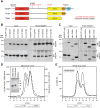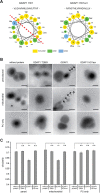Glutathione-conjugating and membrane-remodeling activity of GDAP1 relies on amphipathic C-terminal domain
- PMID: 27841286
- PMCID: PMC5107993
- DOI: 10.1038/srep36930
Glutathione-conjugating and membrane-remodeling activity of GDAP1 relies on amphipathic C-terminal domain
Abstract
Mutations in the ganglioside-induced differentiation associated protein 1 (GDAP1) cause severe peripheral motor and sensory neuropathies called Charcot-Marie-Tooth disease. GDAP1 expression induces fission of mitochondria and peroxisomes by a currently elusive mechanism, while disease causing mutations in GDAP1 impede the protein's role in mitochondrial dynamics. In silico analysis reveals sequence similarities of GDAP1 to glutathione S-transferases (GSTs). However, a proof of GST activity and its possible impact on membrane dynamics are lacking to date. Using recombinant protein, we demonstrate for the first time theta-class-like GST activity for GDAP1, and it's activity being regulated by the C-terminal hydrophobic domain 1 (HD1) of GDAP1 in an autoinhibitory manner. Moreover, we show that the HD1 amphipathic pattern is required to induce membrane dynamics by GDAP1. As both, fission and GST activities of GDAP1, are critically dependent on HD1, we propose that GDAP1 undergoes a molecular switch, turning from a pro-fission active to an auto-inhibited inactive conformation.
Figures



References
-
- Niemann A., Wagner K. M., Ruegg M. & Suter U. GDAP1 mutations differ in their effects on mitochondrial dynamics and apoptosis depending on the mode of inheritance. Neurobiology of disease 36, 509–520 (2009). - PubMed
-
- Pedrola L. et al.. GDAP1, the protein causing Charcot-Marie-Tooth disease type 4A, is expressed in neurons and is associated with mitochondria. Human molecular genetics 14, 1087–1094, doi: ddi121 [pii]10.1093/hmg/ddi121 (2005). - PubMed
Publication types
MeSH terms
Substances
LinkOut - more resources
Full Text Sources
Other Literature Sources
Research Materials

